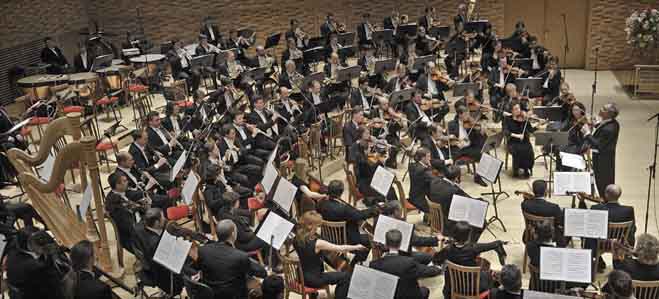Friday, October 21, Roy Thomson Hall, Toronto.
Stravinsky’s balletic score, The Firebird (1919), begins in the spooky domain of an ogre—Kastchei the Deathless. Strings tremble like a thready pulse over the metallic hum of the brass; flutey twitter of birdsong skims the winds’ hollow whisper. The Firebird himself enters like the dawn warming a grey sky—melodic colours begin to flow in tones of clarinet, bassoon, violin and cello, around the captive lovers , then “BAM!!!”, timpany and brass explode and rudely blare, sarcastic xylophone and snares snarl the zany rhythms of a frenetic sabre dance that crescendo the ogre and his aides into a morphic sleep of exhaustion.
Every step of the Mariinsky Orchestra’s way towards The Firebird’s happy ending is happy. Brass, winds, strings and percussion blend their voices to a single sound that Gergiev, with his signature trembling fingers, flies like a gorgeous kite in the sky of the audience’s imagination.
The concert moved from strength to strength with Alexander Toradze playing Prokofiev’s Piano Concerto No. 3 in C Major, Op. 26. Toradze’s recording for Philips with Gergiev conducting the Mariinsky has been named “historically the best on record.”
It is a virutoso work that Prokofiev wrote for himself and premièred himself in Chicago,1921. Full of fantasy, irony, and Russian folk themes echoing Rimsky-Korsakov, this concerto is ornamented with the composer’s familiar barnyard, goose-walk rhythms; at times it boils with impetuous sensuality, at others evoking a transcendental spirituality in the way of Scriabin.
This is a ‘forward-looking’ work, and Toradze hurls himself into it without any holding back, bouncing and rocking with the enthusiasm of a Fats Domino. During the dissonant pair of allegro variations in the second movement and in the blustering opening of the finale, I was delighted by Toradze’s kind of weird intelligence that reminded me of the way Thelonius Monk liked to crab-dance across the keyboard.
The Russian folkloric and martial elements present in the Stravinsky and Prokofiev pieces, as well as their unsettling modernity, were incorporated by Dmitri Shostakovich into his Symphony No. 1 in F minor, Op.10, adding a unifying thread to the evening’s program.
Written and first performed to accolades in 1926, when the composer was turning 20, the orchestration reflects some of the American jazz motifs Shostakovich learned to support his family by playing piano in silent movie theatres. The opening section, a duet of bassoon and trumpet, has flavours of Gershwin’s Rhapsody in Blue, recorded two years earlier—an impression that continues in the vaudevillian allegro march of the first subject.
The melodies are light, fleeting, colourfully orchestrated, strikingly piano-rich, with alternating moods—lyric, nonchalant, satirical and melancholy- hinting-at-the-tragic style that Shostakovich will develop later. There is a surprisingly bold timpani solo followed by gentle, muted cellos before the trumpet brings in the carnival and clowns to blow the top off and away in a very satisfactory final ending.
Your comments are welcome HERE

